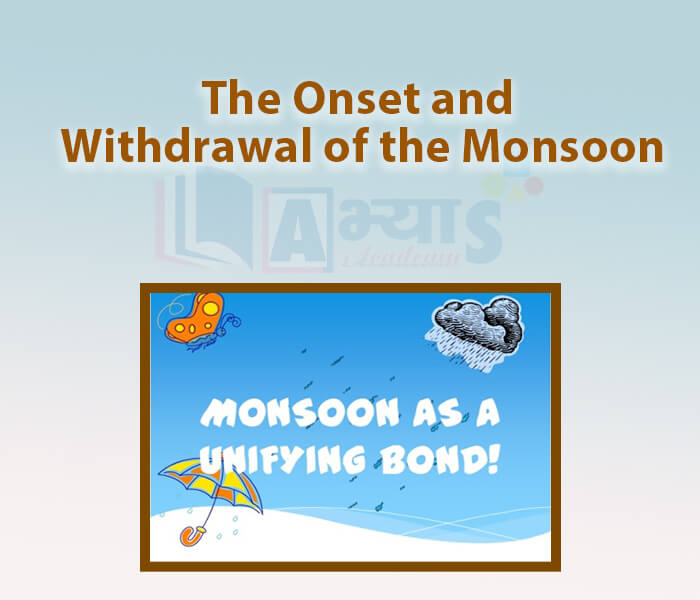The Onset and Withdrawal of the Monsoon













The Onset and Withdrawal of the Monsoon
The Onset and Withdrawal of the Monsoon: The trade winds are steady but the monsoon winds are pulsating in nature. They are affected by different atmospheric conditions encountered by it, on its way over the warm tropical area. Starting from early June in the Southern part of the Indian peninsula, the monsoon lasts between 100 and 120 days, withdrawing by mid-September. Rainfall increases suddenly and continues for several days at the time of arrival of monsoon. This phenomenon is called as Burst of monsoon. It is different from pre-monsoon showers. Afterwards, it alternates with wet and dry spells.
Onset of Monsoon: Monsoon generally reaches the Southern tip of the peninsula during the first week of June. After striking the Southern tip, it branches into two parts- the Arabian Sea branch and ‘the Bay of Bengal branch; both branches move rapidly.
Withdrawal of Monsoon: Withdrawal or the retreat of the monsoon is a more gradual process. The process begins by early September in North-Western states. By mid-October, it withdraws completely from the Northern half of the peninsula.
The withdrawal from the Southern half of the peninsula is fairly rapid. By early December, the monsoon has withdrawn from the rest of the country.
Onset and Withdrawal of Monsoon in the Indian Islands: The islands receive the very first monsoon showers from the la week of April to the first week of May. The withdrawal takes place progressively from North to South (in reverse direction) from the first week of December to the first week of January. By this time, the rest of the country is already under the influence of the winter monsoon.
Important Features of Monsoon: The important features of monsoon are:
The Arabian Sea and the Bay of Bengal branches of the monsoon merge over the northwestern part of the ______ plains | |||
| Right Option : C | |||
| View Explanation | |||
What is a mango shower? | |||
| Right Option : A | |||
| View Explanation | |||
In May - June each year the monsoon winds approach the Southern tip of India from ______________ . | |||
| Right Option : D | |||
| View Explanation | |||
Students / Parents Reviews [10]
My experience with Abhyas is very good. I have learnt many things here like vedic maths and reasoning also. Teachers here first take our doubts and then there are assignments to verify our weak points.

Shivam Rana
7thIt has a great methodology. Students here can get analysis to their test quickly.We can learn easily through PPTs and the testing methods are good. We know that where we have to practice

Barkha Arora
10thIt was good as the experience because as we had come here we had been improved in a such envirnment created here.Extra is taught which is beneficial for future.

Eshan Arora
8thMy experience was very good with Abhyas academy. I am studying here from 6th class and I am satisfied by its results in my life. I improved a lot here ahead of school syllabus.

Ayan Ghosh
8thIt was a good experience with Abhyas Academy. I even faced problems in starting but slowly and steadily overcomed. Especially reasoning classes helped me a lot.

Cheshta
10thAbout Abhyas metholodology the teachers are very nice and hardworking toward students.The Centre Head Mrs Anu Sethi is also a brilliant teacher.Abhyas has taught me how to overcome problems and has always taken my doubts and suppoeted me.

Shreya Shrivastava
8thI have spent a wonderful time in Abhyas academy. It has made my reasoning more apt, English more stronger and Maths an interesting subject for me. It has given me a habbit of self studying

Yatharthi Sharma
10thA marvelous experience with Abhyas. I am glad to share that my ward has achieved more than enough at the Ambala ABHYAS centre. Years have passed on and more and more he has gained. May the centre flourish and develop day by day by the grace of God.

Archit Segal
7thMy experience with Abhyas academy is very good. I did not think that my every subject coming here will be so strong. The main thing is that the online tests had made me learn here more things.

Hiya Gupta
8thBeing a parent, I saw my daughter improvement in her studies by seeing a good result in all day to day compititive exam TMO, NSO, IEO etc and as well as studies. I have got a fruitful result from my daughter.
